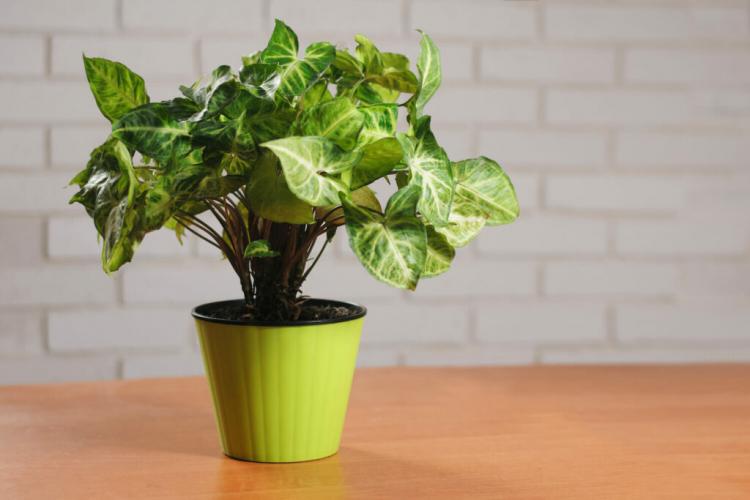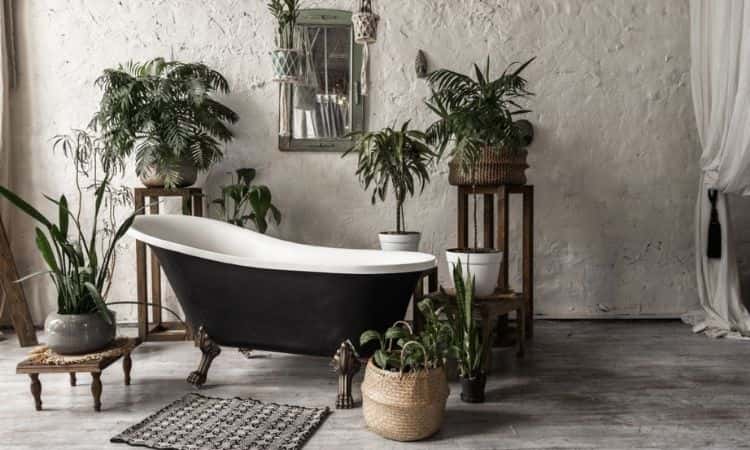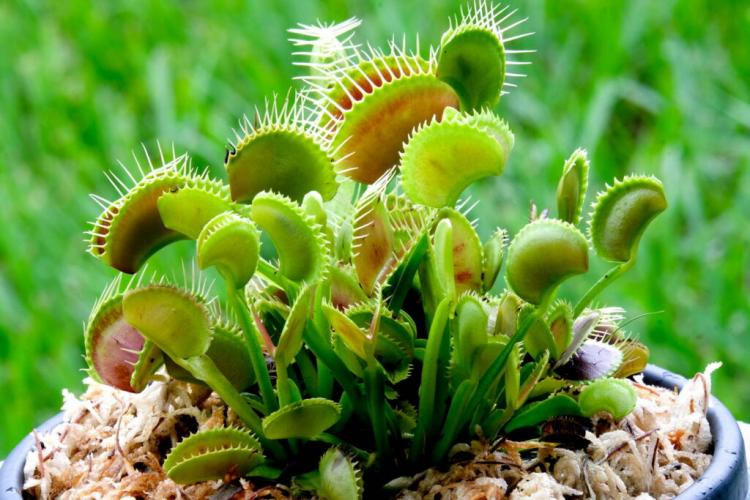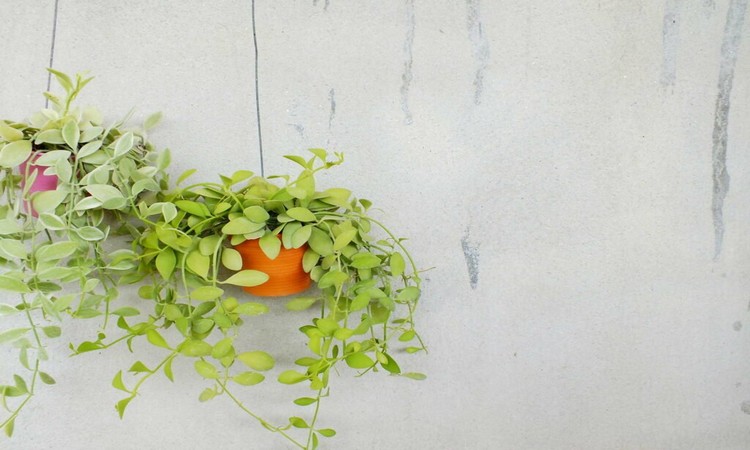Roses In Pot: Caring And Planting A Rose In A Pot
It is a myth that roses need a lot of space. We show you that roses can also be planted in pots and give you tips on choosing varieties and care. If you don’t have enough room in your garden bed for a rose (pink), but still don’t want to do without the queen of flowers, we have a very simple solution for you: After all, smaller roses also thrive wonderfully in a pot on the balcony or in a tub on the terrace.
In general, rose varieties with a rather compact growth are best suited for this purpose. To ensure that your chosen rose produces many beautiful flowers and that you can enjoy your potted plant for as long as possible, you should take a few things into account when planting it.
In this article, we also explain how to take proper care of roses in pots and what measures you should take for a successful wintering. Potted roses have special requirements regarding their location and care due to the limited space available. In the following, we will explain which rose varieties are best suited for the pot and what needs to be considered when planting and caring for them.
Small Rose Varieties For Pot And Tub
Table of Contents
Dwarf roses, bedding roses, or noble roses with a compact growth are ideal for cultivation in pots. Shrub roses and climbing roses should not be too vigorous for pot cultivation, as space in the pot or tub is limited.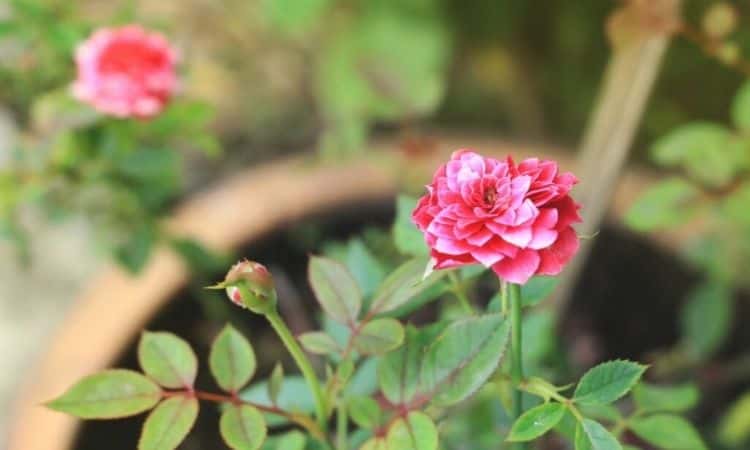
Here is a small selection of roses that are suitable for pot culture:
- Dwarf rose ‘Lavender Ice’
Lavender-colored, medium-sized flowers with a light fragrance; bushy growth; reaches heights between 30 and 50 cm; very good winterhardy. - Dwarf rose ‘Roxy’
Heavily double pink to violet flowers; no fragrance; growth height 30 to 40 cm; bushy habit; good leaf health; conditionally hardy. - Dwarf rose ‘Maidy’
Red, semi-double flowers with white underside; grows rather upright bushy; reaches heights of up to 40 cm; only conditionally hardy. - Bed Rose ‘Amber Queen’
Also called ‘Prince Eugene of Savoy’ in Austria; produces yellow flowers with a slight rose scent; long flowering time; reaches heights up to 60 cm; grows rather upright bushy. - Beet Rose ‘Sirius’
Beautiful semi-double, creamy-white flowers; bushy to upright growth; grows up to 80 cm tall; very good leaf health; good winter hardiness.
A comprehensive collection of rose varieties for the pot and garden bed can be found here.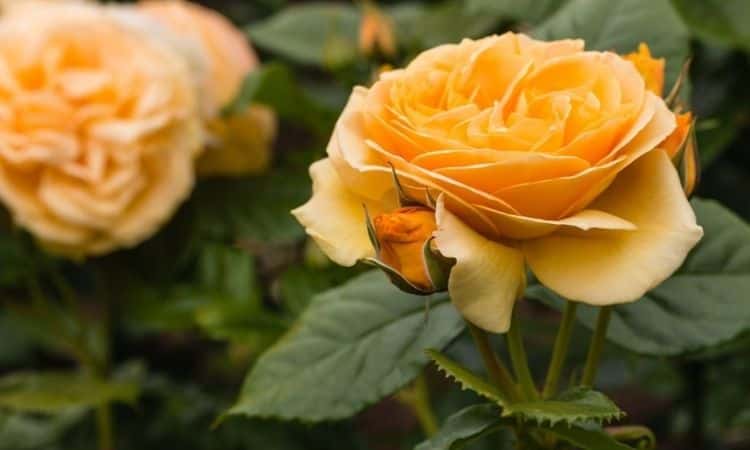
Planting roses in a pot: location and procedure
When buying a rose, make sure that it is healthy and free of pests to avoid unpleasant surprises. The next step is to choose a suitable location on the balcony or terrace. Roses prefer an airy place with lots of sun and warmth.
Strong temperature fluctuations between day and night can increase the risk of frost damage to your pet, especially in early spring. Therefore, the rose in the tub should be moved to a place sheltered from the wind at the beginning of winter and given winter protection.
Since roses are among the deep-rooting plants, you should choose a sufficiently deep pot or tub. The pot should not be an open-pored clay pot, as these lose a lot of water through evaporation and the rose is thus quickly put under drought stress.
Since potted roses do not tolerate permanent waterlogging well at all, it is best to apply a drainage layer of gravel or expanded clay right at the beginning so that excess water can drain away from the hole in the bottom of the pot.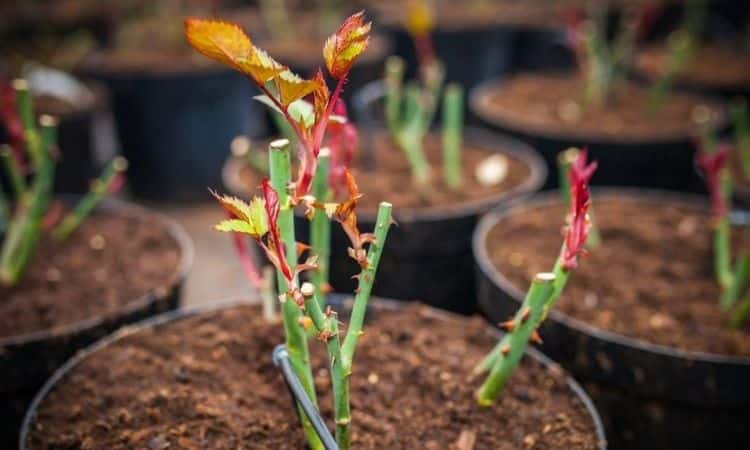
Every few years you should then completely replace the substrate, as even the best substrate will eventually collapse and become increasingly dense, to the detriment of the rose roots.
Summary Planting roses in a pot:
- Dry the root ball or bare roots of the rose in water before planting.
- Shorten the roots a little.
- Fill in drainage material and some soil.
- Do not plant the rose too deep, grafting point just above ground level.
- Fill up with soil, add slow-release fertilizer.
- Press the soil lightly and pour on the well.
- Cover the soil with mulch to prevent rapid drying.
Care for roses in a pot
If you have already ensured good starting conditions when planting, the amount of care required for potted roses will be limited later. We have now summarized for you what you need to consider when watering, fertilizing, and pruning roses in a pot.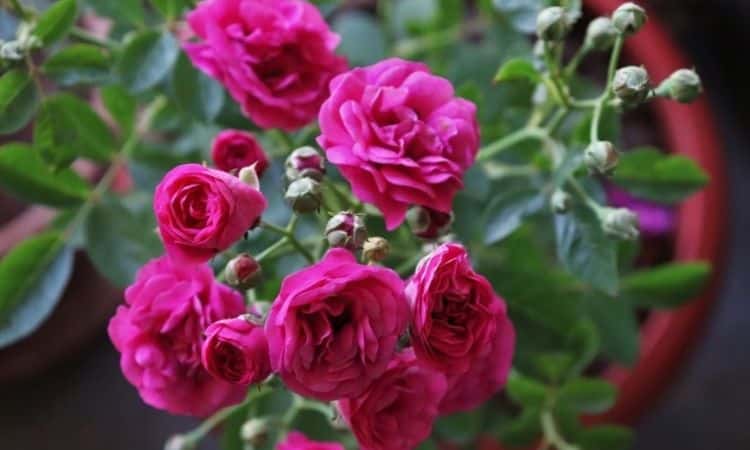
Watering roses in a pot
Roses generally have a rather high water requirement. To find out whether your potted rose should be watered, it is best to do a finger test. When the substrate feels dry 5 cm below the surface, it is high time to water it again.
After watering, your rose should never sink into the water, because waterlogged roses do not tolerate water at all. A drain hole on the underside of the pot and a drainage layer ensures that excess water can drain away.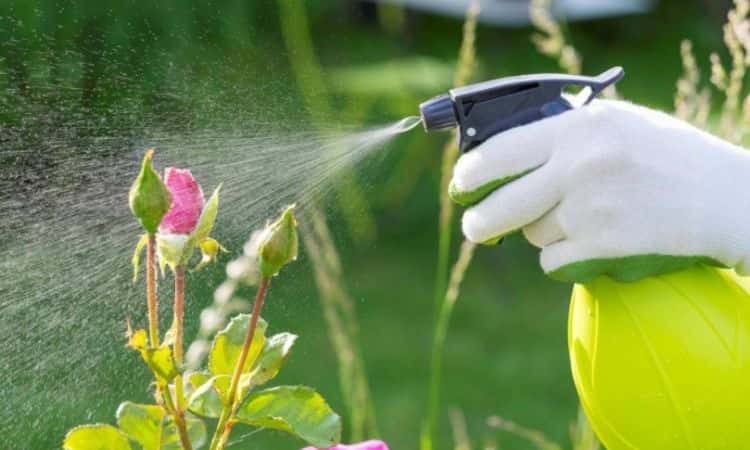
Tip from a professional: Even during hibernation, you should take care when cultivating potted roses that the plant does not dry out completely. However, you should only water on frost-free days so that the roots are not damaged.
Prune roses in a pot
To maintain natural and healthy growth and rich flowering, you should prune your roses in spring (March/April) just before new shoots appear. First remove all diseased, dried out, and too dense shoots with sharp garden shears.
Depending on the rose class, further procedures will then differ. Shrub roses, for example, are hardly touched at all, only every few years old shoots are removed. Beetroses, on the other hand, are radically cut back to a few buds above the ground every spring.
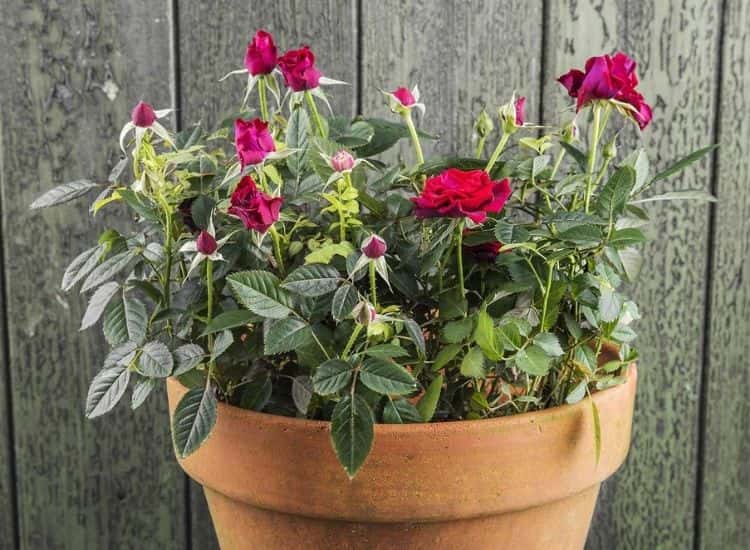
You can read everything about the cutting of the different rose classes as simple instructions in our article on how to prune roses correctly.
Fertilizing roses in a pot
Already when planting potted roses, you can use some mainly organic slow-release fertilizer specifically for the needs of roses. Over time, the fertilizer decomposes and gradually releases the nutrients to the plant. Roses have a relatively high nutrient requirement.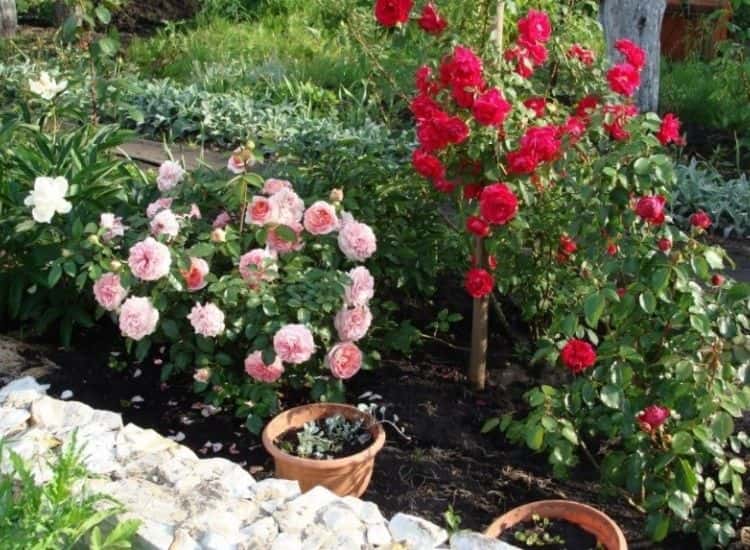
If you prefer to use a fertilizer with a long-term effect, two to three fertilizations per year are completely sufficient. You can find out more about fertilizing roses in our special article.
Roses in a potted winter
If you want to winter your pot rose outside, you should bear in mind that some rose varieties are not completely hardy and can be damaged by severe frost. Therefore, you should choose a sheltered spot for the cold season – for example on a house wall – and take suitable protective measures early enough.
Here, additional protection of the roots is of great importance. Direct ground contact should be avoided if possible. It is, therefore, best to place the pot or bucket on a wooden or polystyrene board. Afterward, heap up the rose with soil, mulch, or fir greenery in order to protect the grafting site as best as possible.
It is also advisable to cover the entire center of the rosebush with fir greenery and to provide high-stem roses with a crown cushion and stem protection. Finally, cover the pot with jute bags or bamboo mats and tie them up.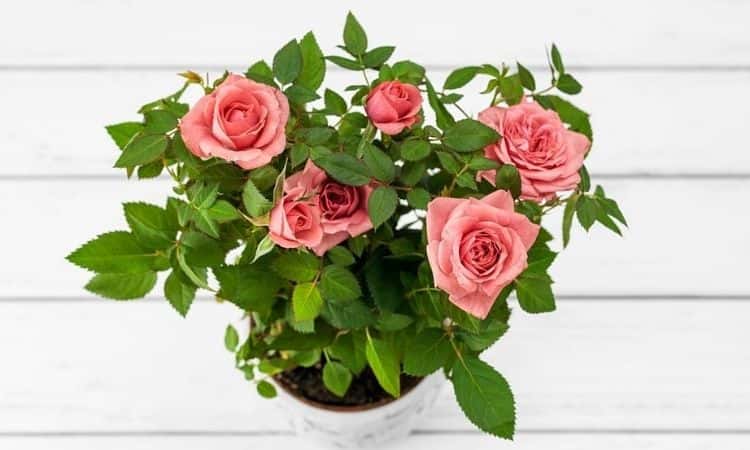
Well-protected, there is usually nothing to stand in the way of a successful wintering. If your garden is endangered by late forestation and you usually have a rough climate, you should bring the potted roses into the house and place them in a cool, dark room, for example in the cellar.
Stem roses are particularly decorative and can be kept in a container very well. In our special article, you will find the best varieties of stem roses.

